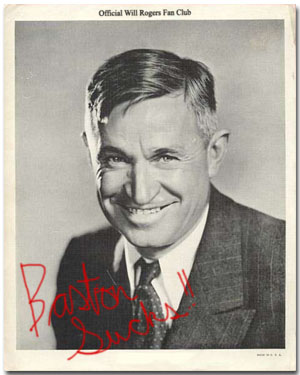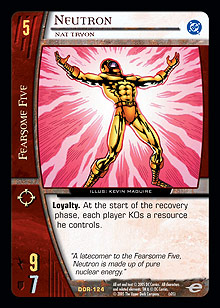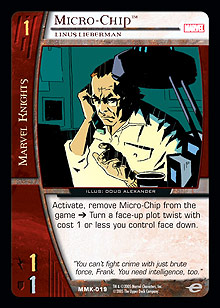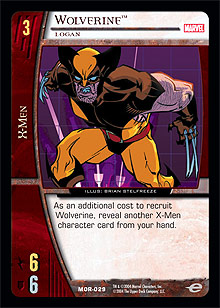
 Although I have recently been transplanted to the great city of Dallas, I am an Oklahoma native. The drubbing that the Texas Longhorns recently gave to my beloved Oklahoma Sooners notwithstanding, I am proud of my home state and heritage. In fact, I have made every effort to live my life according to the model of a very famous Oklahoma native, Will Rogers. As most people know, Will Rogers had a famous saying: “I never met a man I didn’t like.”*
Although I have recently been transplanted to the great city of Dallas, I am an Oklahoma native. The drubbing that the Texas Longhorns recently gave to my beloved Oklahoma Sooners notwithstanding, I am proud of my home state and heritage. In fact, I have made every effort to live my life according to the model of a very famous Oklahoma native, Will Rogers. As most people know, Will Rogers had a famous saying: “I never met a man I didn’t like.”*
Of course, Will Rogers never had the pleasure of meeting Bastion.
We Don’t Need No Stinkin’ Robots!
While I am openly free to hate most Sentinels (as most of them are robots), Bastion is actually the human fusion of Nimrod and Master Mold (as evidenced by his flavor text). If I were to stay true to the sage words of Will, I should like Bastion.
But I don’t. I hate Bastion with an undying fury!
I can handle the unbridled weenie hate that the Sentinels possess in Search and Destroy, Total Anarchy, and Flame Trap. I can handle the brokenness of the super-reinforcing and the dual utility of Sentinel Mark V on turns 4 and 5. I can even accept the “you’re gonna have to attack me again to stun me, fool!” monstrosity that is Nimrod. If those cards were all that the Sentinels possessed, they would be a very good team. But throwing Bastion into the mix makes them absolutely nuts.
Anyone who has read some of my Internet ramblings on VsRealms knows that the reason I believe Bastion is so effective is that he turns otherwise dead cards in hand (i.e., character cards) into useful offensive or defensive tools. For most decks, drawing your 2-drop on turn 6 is a bad thing. With Curve Sentinels, however, your Hounds of Ahab can easily be converted into a +1 ATK / +1 DEF pump for any character on the board.
Given the immense power and synergy of Bastion and his Sentinels, most competitive Vs. System players have resorted to one of the following three strategies to beat the ’bots:
1) Play Curve Sentinels. (If you can’t beat ’em, join ’em!)
2) Play a deck that can hold off the Sentinels until later turns when your deck will be more effective than your opponent’s (Jason Scudder’s Spider Knights and the Hong Kong Cavaliers’ NewSchool decks are examples of this).
3) Play a deck that will win the game before Bastion can become effective.
This last strategy is of particular interest to me. But of course I have a particular affinity for this strategy—it’s the method I used at Pro Circuit New York with the Xavier’s Dream deck. More recently, players like David Leader and Maik Stich have found success with aggressive concealed decks that attempt to win the game on or before turn 5.
One big problem with both of these deck ideas is that if their strategies falter and they allow Bastion to become part of the game, they will usually lose. Bearing this in mind, how would they fare if they could stop Bastion from ever hitting the board?
The Leader of Operation: Zero Tolerance has Left the Building
At $10K Detroit, Jason Grabher-Meyer wrote an intriguing deck profile for a Vs. System player named Rubin Parry. Rubin’s deck was an amalgamation of several early game board control strategies.** Danger Room and Madripoor made the already formidable X-Men weenies even more formidable. Fastball Special allowed the little characters to take down larger opposing characters. Finally, Surprise Attack and X-Corporation allowed for dramatic shifts in endurance.
The one card in Rubin’s deck that really caught my eye was the underappreciated Fearsome Five-drop, Neutron. As JGM so eloquently stated in the deck profile, “Ever since his release in DC Origins,Neutron has reeked of two things: unfulfilled potential and awesomeness.” Indeed. Neutron has the potential to create all kinds of problems for decks that rely on late-game dominance.
The Build
 In order to break Neutron, we’re going to build a deck that can do two things: 1) establish and control a strong early game (five or fewer resources), and 2) possess the ability to recover a stunned Neutron during the combat phase (as his effect won’t go on the chain at the start of the recovery phase if he is stunned).
In order to break Neutron, we’re going to build a deck that can do two things: 1) establish and control a strong early game (five or fewer resources), and 2) possess the ability to recover a stunned Neutron during the combat phase (as his effect won’t go on the chain at the start of the recovery phase if he is stunned).
Obviously, Fearsome Five will need to be one of the teams in our build. But what other teams should we consider? Let’s take a look at our second requirement. While there are some generic cards that can recover a character, they all have pretty hefty costs. There are several teams, though, that have recovery cards with more reasonable costs. Of course, the foremost on this list (as Rubin knows) is the Uncanny X-Men. Children of the Atom is simply the best character recovery card in the game. Because of this, we will include everybody’s favorite mutant team.
Unlike Rubin, however, we will not stop at two teams. When we consider our first requirement, we see that there are several characters that can assist in maintaining board presence. But these characters are spread across a diverse array of teams. In order to utilize the various characters, we will need a team that can bring them all together.
Enter the Marvel Knights! Most everyone is well aware by now of how the combo of Dagger, Child of Light and Midnight Sons allows decks to incorporate a variety of teams. Add in the fact that Wild Ride is well-suited for our deck’s purpose (as it’s full of low-cost characters), and we have a very strong third team with which to support our build.
Let’s go ahead and make a basic list of all of the cards we have already mentioned for inclusion:
4 Dagger, Child of Light
2 Neutron
4 Children of the Atom
4 Midnight Sons
4 Wild Ride
Now let’s consider what additional plot twists we want to include. Since we will have several teams in the build, it probably wouldn’t hurt us to have some additional Team-Ups for support. So, we’ll include two copies of Millennium. Also, character search cards are very nice to have, and we have another viable search card for the Fearsome Five in The Underworld Star. However, The Underworld Star isn’t quite as effective as Wild Ride, so we’ll only include two.
Of course, having a few attack pumps would not be bad. While the general consensus is that Savage Beatdown is the strongest attack pump in Vs. System, we might need cards with more utility (especially with Null Time Zone popping up in the metagame). We’ll go ahead and split six spots in the deck between Flying Kick and No Man Escapes the Manhunters. Both are more useful in this deck than Savage Beatdown because they can be used in earlier turns, have helpful effects other than the ATK increase, and are not limited to being played on an attacking character.
Finally, we should consider a card that will allow us to use our horde of smaller characters to stun well up the curve—Fastball Special. Since we will (hopefully) have several characters on the board at any given time, we can use this little gem to stun 4- and 5-drops for the low, low cost of exhausting a couple of small characters. Three copies.
On the location front, there’s only one card that leaps to mind. With our horde of weenies and potential discards for Children of the Atom, we have a real concern about keeping enough cards in hand. As we have already concluded, we plan to have several characters on the board. So, having a copy of Birthing Chamber would make sense. While it is a nice card to have, we really don’t want to draw into more than one copy. We’ll limit Birthing Chamber to three copies in our deck.
 Let’s move on to character selection. We have already established a 1-drop and a 5-drop. We’ll fill out our selections at those drops, and then fill out the cards in the middle. Looking at the 1-drops, we notice that there are several 1-cost plot twists in the deck. Recycling these cards is never a bad thing. Thus, we should consider Micro-Chip. Let’s include four copies. Staying with the Marvel Knights 1-drops, Mikado and Mosha can definitely be useful against other troublesome 1-drops. Let’s include two copies of the Angels of Destruction.
Let’s move on to character selection. We have already established a 1-drop and a 5-drop. We’ll fill out our selections at those drops, and then fill out the cards in the middle. Looking at the 1-drops, we notice that there are several 1-cost plot twists in the deck. Recycling these cards is never a bad thing. Thus, we should consider Micro-Chip. Let’s include four copies. Staying with the Marvel Knights 1-drops, Mikado and Mosha can definitely be useful against other troublesome 1-drops. Let’s include two copies of the Angels of Destruction.
We hope that our games won’t extend much past turn 5—hopefully, no more than two turns beyond. Still, we’ll need a couple more 5-drops to recruit in the later turns. Daredevil, Matt Murdock, another solid Marvel Knights character, comes to mind in the 5-cost slot. He is a very large 5-drop with a very usable effect in a combat deck. Switching over to the X-Men, we find a similarly large 5-drop in Archangel, Angel of Death.*** Not only does he have a respectable ATK for a 5-drop, but his effect also works very well with Daredevil, Matt Murdock and Flying Kick. One copy of each of these brutes will go into our build.
This leaves us eighteen spots to fill with our 2-, 3-, and 4-drops. Let’s allocate seven of the spots to our 2-drops, six spots to our 3-drops, and the remaining five spots to our 5-drops.
At 2, we should probably include at least two copies of Shimmer. Not only does she fit the need for additional Fearsome Five characters, but she also has a nice board control effect for turns when you control the initiative. We should also look at some of the X-Men 2-drops, as they are some of the best in the game. Between Nightcrawler, Kurt Wagner; Bishop; and Cyclops, Slim, we have three very formidable characters. In fact, it’s difficult to decide which of these three characters is the best of the group. So, we’ll err on the side of diversity and select one copy of each. Finally, since the Marvel Knights don’t possess any spectacular 2-drops, we’ll throw in a couple of copies of everyone’s favorite stall artist, Puppet Master. While Puppet Master is somewhat contrary to our theme of early game aggression, he can be invaluable for limiting our opponent’s options on turns when we don’t control the initiative.
 We have a couple of easy choices at the 3-slot. Of course, we need to include the X-Men’s 3-drop powerhouse Wolverine, Logan. But we’ll only need a couple copies of him, because we have something more devious in mind for our remaining four spots. Since we are attempting to control the board with small characters, it would definitely benefit us to have a method of increasing the number of characters we have in play. Of course, anyone who has played in a DC Modern Age tournament knows the amazing board advantage that Dr. Light, Master of Holograms can provide (inspired by Ryan Gutierrez, a.k.a. RyanDG). Besides, since we can’t include the Fearsome Five’s version of the good doctor, we might as well find a way to incorporate his smaller (yet no less lethal) version.
We have a couple of easy choices at the 3-slot. Of course, we need to include the X-Men’s 3-drop powerhouse Wolverine, Logan. But we’ll only need a couple copies of him, because we have something more devious in mind for our remaining four spots. Since we are attempting to control the board with small characters, it would definitely benefit us to have a method of increasing the number of characters we have in play. Of course, anyone who has played in a DC Modern Age tournament knows the amazing board advantage that Dr. Light, Master of Holograms can provide (inspired by Ryan Gutierrez, a.k.a. RyanDG). Besides, since we can’t include the Fearsome Five’s version of the good doctor, we might as well find a way to incorporate his smaller (yet no less lethal) version.
Finally, we need to pare down our choices at the 4-drop slot. First and foremost, in tribute to the TOGIT team and their legendary X-Stall deck, we might want to consider at least one copy of Rogue, Power Absorption. As I said earlier, one copy of Puppet Master on the board can really be beneficial for turns when we don’t control the initiative. I would wager that having two copies of Mr. Masters would be even better! Of course, it might be nice if we had some other characters that Rogue could copy. Since we would probably be wise to protect ourselves against early game rush decks, we’ll also include a copy each of Gambit, Remy Lebeau and Cloak, Child of Darkness. While neither is much of an offensive threat, they are both strong choices for keeping low drops in check during the turns when we don’t control the initiative. Finally, Polaris, Lorna Dane has great synergy with Archangel, so we might want to include her as well. Not only can she give us potentially un-stunnable attackers, but she can also force our opponents to move any characters they want to counterattack with into the front row (as they would be unable to attack otherwise). Two copies of the mistress of magnetism.
With that, we have reached the magic number of 60 cards. So, let’s take a look at our mad creation!
The Neutron Dance (60 cards)
4 Dagger, Child of Light
4 Micro-Chip
2 Mikado and Mosha
1 Bishop
1 Cyclops, Slim
1 Nightcrawler, Kurt Wagner
2 Puppet Master
2 Shimmer
4 Dr. Light, Master of Holograms
2 Wolverine, Logan
1 Cloak, Child of Darkness
1 Gambit, Remy Lebeau
2 Polaris
1 Rogue, Power Absorption
1 Archangel, Angel of Death
1 Daredevil, Matt Murdock
2 Neutron
4 Children of the Atom
3 Fastball Special
3 Flying Kick
4 Midnight Sons
2 Millennium
3 No Man Escapes the Manhunters
2 The Underworld Star
4 Wild Ride
3 Birthing Chamber
With the number of search cards in the deck, we shouldn’t have much trouble working into our curve as the game progresses. If we mulligan for Wild Ride and Dagger / Micro-Chip / Midnight Sons, we should have a successful set of early turns.
It might also be possible for us to work some other creative combos into the build. Another imaginative option (also inspired by RyanDG) would be to work toward getting Longshot and Malvolio on the board together to improve our card drawing in later turns.
That’s all for this week. Keep the suggestions for future articles coming. You can email any suggestions to me at BigSpooky1@hotmail.com.
* Of course, something that most people don’t know is that, in general, Oklahomans are taller than the average American. Fortunately, having Tim Batow in our state keeps us close to the national average.
** Don’t you hate it when writers use big words like “amalgamation?” Well, I don’t! If you don’t understand what I’m saying, go pay a visit to www.dictionary.com. You might even learn something. I’ve already doubled my vocabulary reading Tim Willoughby’s articles.
*** Besides, it’s poetic justice that if we include the Angels of Destruction, we also include the Angel of Death. Of course, I suppose the fact that we’re including both Cloak, Child of Darkness and Dagger, Child of Light is even more poetic!